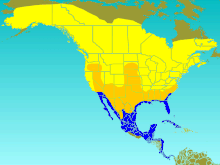Tree swallow
| Tree Swallow | |
|---|---|

| |
| In Madison, Wisconsin, USA | |
| Scientific classification | |
| Kingdom: | |
| Phylum: | |
| Class: | |
| Order: | |
| Family: | |
| Genus: | |
| Species: | T. bicolor
|
| Binomial name | |
| Tachycineta bicolor (Vieillot, 1808)
| |

| |
| Synonyms | |
|
Iridoprocne bicolor | |

The Tree Swallow, Tachycineta bicolor, is a migratory passerine bird that breeds in North America and winters in Mexico, Central America and the Caribbean. It is a very rare vagrant to western Europe.
This swallow averages 13.5 cm (5 inches) long and weighs about 20 g. The bill is tiny. The adult Tree Swallow has iridescent blue-green upperparts, white underparts, and a very slightly forked tail. The female usually has duller colours than the male, often more greenish than the more bluish male. The juvenile plumage is dull grey-brown above and may have hint of a gray breast band.
Being highly social outside of the breeding season, tree swallows may form flocks of several thousand birds near roost sites.[1] Flocks near Vacherie, Louisiana were estimated to contain well over 1 million birds during December 2009.[2]
Breeding


Tree Swallows nest in natural or artificial cavities near water and are often found in large flocks. They readily use nest boxes, including those built for bluebirds. Declines in cavity-builder populations are resulting in fewer natural nesting sites for Tree Swallows, although the swallow population remains healthy.
The Tree Swallow nest consists of multiple layers of grasses and thin twigs, and is lined with large feathers from other species. The female lays 4 to 7 white eggs and incubates them by herself. The eggs hatch in about 14 days and the hatchlings are altricial. The hatchlings typically fledge in 16–24 days. While there are young or eggs in the nest, adults frequently dive bomb intruders (including curious humans) and attempt to drive them from the area. Tree Swallows are known to "fight" over feathers in mid-air for reasons which are still under investigation. There is some speculation that this is a form of play.
Tree Swallows are typically single-brooded, although they may attempt a second nest if the first fails early in the season. There are records of parents raising two successful broods in a season.
They subsist primarily on a diet of insects, sometimes supplemented with small quantities of fruit. They are excellent fliers and take off from their perch and acrobatically catch insects in their bills in mid-air.
References
- Template:IUCN2006 Database entry includes justification for why this species is of least concern
External links
- Tree Swallow - USGS Patuxent Bird Identification InfoCenter
- Tree Swallow species account, Cornell Lab of Ornithology
- Tree Swallow information and photo, South Dakota Birds and Birding
- How to create and manage nest box projects for Tree Swallows
- Tree Swallow videos on the Internet Bird Collection
- Tree Swallow photo gallery VIREO
- Tree Swallow, Birds of Nova Scotia
- Tree Swallow, borealforest.org
- IUCN Red List least concern species
- Use dmy dates from September 2010
- Tachycineta
- Birds of North America
- Birds of Central America
- Birds of the Greater Antilles
- Birds of the Caribbean
- Birds of Canada
- Native birds of Alaska
- Birds of the United States
- Birds of Baja Peninsula Mexico
- Birds of Mexico
- Birds of the Yucatán Peninsula region
- Birds of the United States Virgin Islands
- Birds of Cuba
- Birds of Haiti
- Birds of the Bahamas
- Birds of the Turks and Caicos Islands
- Birds of Colombia
- Birds of French Guiana
- Birds of Guyana
- Birds of Venezuela
- Birds of Saint Pierre and Miquelon
- North American migratory birds

